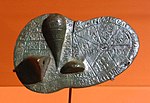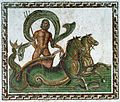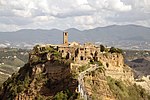The Liver of Piacenza is an Etruscan artifact found in a field on September 26, 1877, near Gossolengo, in the province of Piacenza, Italy, now kept in...
8 KB (862 words) - 12:23, 12 November 2024
Liver of Piacenza, a bronze model of a sheep's liver for the purposes of haruspicy was discovered in 1877 at Gossolengo just to the south of Piacenza...
44 KB (4,753 words) - 10:34, 25 October 2024
Usil (category Epithets of Śuri)
bronze liver of Piacenza, next to Tiur, meaning both "moon" and "month", since then Tiur has been identified as the name of the personification of the moon...
5 KB (525 words) - 12:25, 12 October 2024
Śuri (category Pages displaying short descriptions of redirect targets via Module:Annotated link)
face) of the bronze Liver of Piacenza, which is separated into two lobes. Initially, some researchers supposed that the first lobe, where the gods of the...
76 KB (6,974 words) - 00:33, 17 November 2024
Uni (mythology) (section The Judgement of Elcsntre)
BC. This seems to refer to Uni. She also appears on the Liver of Piacenza. The name Uni is of uncertain etymology, however may be related to an Indo-European...
19 KB (2,454 words) - 18:46, 16 September 2024
liver while a crowd gathers near him. Another significant artifact relating to haruspicy in Ancient Italy is the Piacenza Liver. This bronze model of...
12 KB (1,353 words) - 12:51, 3 October 2024
to be a curious omission, his name does not appear on the bronze liver of Piacenza. King, C. W. (Charles William) (1872). Antique gems and rings. Getty...
1 KB (138 words) - 07:44, 4 September 2023
Satre or Satres was an Etruscan god who appears on the Liver of Piacenza, a bronze model used for haruspicy. He occupies the dark and negative northwest...
3 KB (346 words) - 08:54, 12 October 2024
addition in the place of offering, and in the ichu house L. Bouke van der Meer (1987). The bronze liver of Piacenza. Analysis of a polytheistic structure...
2 KB (324 words) - 05:28, 5 October 2024
was originally a god of water). Nethuns is mentioned on the Piacenza liver, a third-century BC bronze model of a sheep's liver used for divinatory rites...
2 KB (248 words) - 05:09, 9 January 2023
Liver of Piacenza, being listed among the 16 gods that rule the Etruscan astrological houses. He is the 9th of those 16 gods. He is the son of Semla and...
6 KB (768 words) - 03:00, 23 October 2024
Etruscan civilization (redirect from History of the Etruscans)
Sarcophagus of Laris Pulenas – grave inscription of Laris Pulena with nine lines of text on a sarcophagus scroll Liver of Piacenza – model of a sheep's liver with...
108 KB (11,982 words) - 13:45, 24 October 2024
this sanctuary]." Cel appears on the Liver of Piacenza, a bronze model of a liver marked for the Etruscan practice of haruspicy. She is placed in House 13...
2 KB (230 words) - 04:46, 24 August 2021
Liber Linteus (redirect from Etruscan Book of the Dead)
claims that many of the locations in the year of these deities' rituals correspond to the same deities' locations on the Liver of Piacenza and in other Etruscan...
25 KB (3,582 words) - 15:03, 7 October 2024
ISBN 9781931707862 van der Meer, L. Bouke (1987). The Bronze Liver of Piacenza: Analysis of a Polytheistic Structure. Vol. 2 vols. Amsterdam: J.C. Gieben...
17 KB (1,953 words) - 16:30, 10 November 2024
Lucius Tarquinius Superbus (redirect from Tarquinia (daughter of Tarquin the Proud))
legendary seventh and final king of Rome, reigning 25 years until the popular uprising that led to the establishment of the Roman Republic. He is commonly...
23 KB (2,986 words) - 00:16, 2 September 2024
Apulu (category Epithets of Śuri)
representation is the Apollo of Veii, attributed to Vulcas. He does not appear on the Liver of Piacenza. The national divinity of the Greeks, Apollo has been...
10 KB (903 words) - 01:33, 11 November 2024
Etruscan alphabet (redirect from Romanization of Etruscan)
The Etruscan alphabet was used by the Etruscans, an ancient civilization of central and northern Italy, to write their language, from about 700 BC to sometime...
20 KB (982 words) - 23:23, 26 June 2024
Piacenza is a city in Italy. Piacenza may also refer to: Province of Piacenza, a province in Italy Piacenza d'Adige, a town in Italy Piacenza, Wisconsin...
1 KB (143 words) - 16:33, 1 September 2024
Old Italic scripts (redirect from Alphabet of Lugano)
The Old Italic scripts are a family of ancient writing systems used in the Italian Peninsula between about 700 and 100 BC, for various languages spoken...
26 KB (1,559 words) - 19:33, 31 October 2024
name is found in two places on the Liver of Piacenza: on the outer rim of section seven, and on the gallbladder of section 28. This last location aligns...
39 KB (4,798 words) - 20:01, 19 November 2024
Nigidius Figulus (category Philosophers of Roman Italy)
scholar of the Late Roman Republic and one of the praetors for 58 BC. He was a friend of Cicero, to whom he gave his support at the time of the Catilinarian...
11 KB (1,309 words) - 07:24, 14 November 2024
Etruscan language (category Languages of ancient Italy)
the noble Velthinas. The Piacenza Liver, a bronze model of a sheep's liver representing the sky, has the engraved names of the gods ruling different...
121 KB (12,223 words) - 02:33, 16 November 2024
Civita di Bagnoregio (category Frazioni of the Province of Viterbo)
outlying village of the comune of Bagnoregio in the Province of Viterbo in central Italy. It lies 1 kilometre (0.6 mi) east of the town of Bagnoregio and...
15 KB (1,801 words) - 07:02, 12 November 2024
or other symbols. Etruscan numerals are the words and phrases for numbers of the Etruscan language, and the numerical digits used to write them. The Etruscan...
17 KB (2,004 words) - 11:32, 12 October 2024
Etruscan terracotta warriors (category Sculptures in the Metropolitan Museum of Art)
the work of the ancient Etruscans, but are in fact art forgeries. The statues, created by Italian brothers Pio and Alfonso Riccardi and three of their six...
5 KB (618 words) - 19:08, 25 March 2024
the Roman Empire. The container consists of a vessel, usually in terracotta, perforated to allow the passage of air, polished on the inside to prevent escape...
2 KB (179 words) - 18:42, 7 June 2024
Nortia (section Ritual of the nail)
among those of the deities on the Liver of Piacenza. She appears a few times in Latin literature and inscriptions. She is mentioned in one of Juvenal's...
11 KB (1,484 words) - 19:51, 26 August 2024
extinct family of closely related ancient languages put forward by linguist Helmut Rix in 1998, which consists of the Etruscan language of northern, central...
32 KB (3,565 words) - 10:58, 6 November 2024
early years of the Republic. Their nomen is derived from the Etruscan praenomen Lars. Titus' brother, Spurius Larcius, was one of the heroes of the Republic...
9 KB (1,001 words) - 21:09, 23 June 2024

















